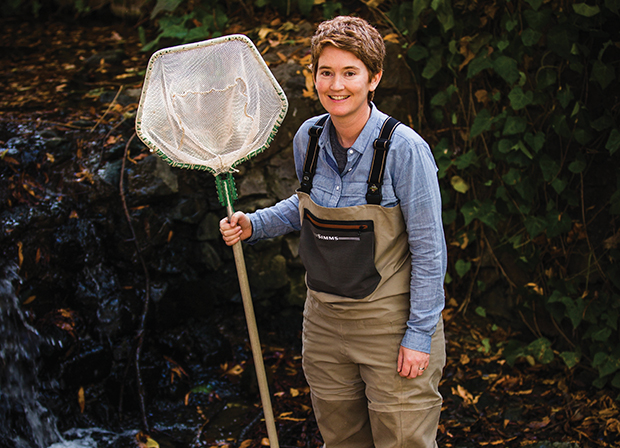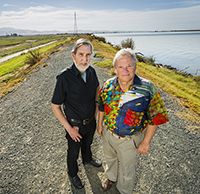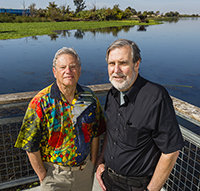California’s Delta
On the Front Lines of the State’s Water Issues
On June 3, 2004, a small trickle of water started to flow through a levee on the Jones Tract, a patch of farmland west of Stockton that sits below sea level. Of California’s 27 million acres of irrigated croplands, the tract’s 12,000 acres weren’t exactly at the forefront of anyone’s mind. But within a few hours the rivulet had become a deluge, opening a 350-foot-long gash in the wall that was built to hold back the waters of the Sacramento–San Joaquin Delta. The land quickly became a lake, submerging asparagus fields, corn silos, and dozens of homes beneath 60 million gallons of water. Repairing the break required six months of constant pumping and cost approximately $100 million; farmers throughout the Central Valley, who depend on the delta’s 1,100-mile-long network of levees, had a new reason to lose sleep at night. The cause of the initial rupture was a beaver, working to expand its home.
California water: Few natural resources are as impressive, or as imperiled. Whether it’s supplying 40 million domestic users, cooling the server farms of Silicon Valley, or irrigating the actual farms that supply half of the nation’s produce, the importance of the state’s aquifers and headwaters cannot be overstated. (Lake Tahoe, Yosemite Falls, and white-water rafting on the Kern and American Rivers feel like an embarrassment of riches.) While the potential for a multi-decade drought has grabbed headlines, however, California’s water supply faces assault from a host of lesser-known factors including infrastructure failure, pollution, habitat loss, and plain old political chaos. This issue is strongly interdisciplinary, so it’s only natural that College of Natural Resources professors and students have been at the forefront of analyzing the problems and beginning the search for solutions. Several Berkeley professors have even served on the Delta Independent Science Board (DISB), a group of experts appointed by the state to oversee the quality of scientific research on California’s contentious delta water issues.
Supply vs. Demand
When asked to name the three greatest threats to California’s water, Richard Norgaard, professor of energy and resources (and the DISB’s first chair, who still serves on the board), couldn’t be more clear. “Issue number one, one, and one is that a substantial portion of the acreage in agriculture is supported through groundwater overdraft, even in normal-rainfall years,” he says.
According to the U.S. Geological Survey, California’s cities, factories, and farms soak up about 38 billion gallons every day. And while most people think of water in terms of rivers, lakes, and rain, over a third of the state’s supply comes from aquifers deep underground. Only one in six Californians relies on groundwater alone to supply their domestic needs. “We’ve been mining water to expand use beyond surface-water allocations,” says Norgaard. “Groundwater is close to gone, and agriculture is saying, ‘Where’s our water, where’s our water, where’s our water?’”
Given that much of California is a desert—and that decades-long droughts are not impossible—intelligently managing California’s limited supply is crucial. Governor Jerry Brown recently ordered municipalities to cut home water usage by a whopping 25 percent, and California residents gave themselves a well-deserved pat on the back when usage for July 2015 surpassed that target by 6 percent. But there’s one problem: Domestic use accounts for only 10 percent of California’s total water consumption. Agricultural use, on the other hand, accounts for closer to 40 percent.
At first glance, that doesn’t seem entirely inappropriate. Fruits, vegetables, and nuts, not to mention Northern California’s incomparable wine and cheese—why shouldn’t the farmers who feed half of the nation take half of the water that the state has to offer? “Do you know what percent of the state’s economy is agriculture?” asks Vincent Resh, a professor in the Department of Environmental Science, Policy, and Management (ESPM) and another DISB member. “Less than 2 percent.” It’s a very vocal 2 percent, though, and there are volumes of case law—and a good amount of political muscle—dedicated to maintaining the status quo. “I’m very sympathetic toward the plight of farmers in the delta,” Resh continues. And farmworkers are the poorest of California’s poor, with seasonal unemployment rates reaching upwards of 60 percent. “It’s the human side of the story that I’ve become extremely sensitive about.”
Nonetheless, Resh recalls being on a delta tour that was packed with people who identified themselves as delta farmers. “They were all talking about how this has been their family heritage for generations, but they were working as lawyers and bankers. They were really talking about a way of life that was long gone for them personally, but a memory that they were holding on to. Actually, this ‘way of life’ idea is true of many of the contentious water issues in California. The controversies over who gets the water in the Klamath River in Northern California and Oregon are as much about way of life as they are about water for agriculture and salmon.”
A Fragile Water System
Nobody is suggesting an outright end to farming in California, but it’s becoming increasingly clear that change is coming. One looming problem is the fragility of the levee system. Drive around Sacramento’s rural environs and you’ll realize that a lot of farmers actually do their work below sea level, with nothing but a hodgepodge system of peat dams and concrete rubble to restrain the brackish delta waters. Overactive beavers, like the one on the Jones Tract, are the least of the problem.
Like everyone else in California, the engineers who watch over the delta’s levee system are at the mercy of probability, breathing a sigh of relief every day that goes by without the catastrophic shaking of the Big One. “In any given year there’s not a large chance of a huge earthquake,” says David Sunding, chair of the Department of Agricultural and Resource Economics. “But those risks accumulate over time. And by the time you look two decades into the future, there’s a two-thirds chance of a very large quake that will affect the delta’s water system.” Even an apparent bounty—consecutive years of high rainfall—poses risks. River flows would rise along with reservoir levels, placing added stress on levees so that even a minor structural failure could set off a chain reaction, flooding fields and devastating crops.
“The current proposals for achieving reliable water supply and ecosystem health may be controversial, but it’s clear that something has to be done—we can’t have the status quo.”
— Vincent Resh
Inherent in either of these scenarios is the threat to drinking water. The delta houses the State Water Project, two massive pumps that send water to Southern California. If the levees are overtopped, the salt water of the bay will infiltrate the Sacramento and San Joaquin Rivers, rendering the supply undrinkable. “The worst-case scenario is three months without water,” says Resh. “And that’s from Fremont down. Silicon Valley, Los Angeles, everything.”
Not Just a Human Problem
Of course, farmers and thirsty urbanites aren’t the only ones who need water. According to ESPM associate professor Stephanie Carlson, “many of California’s native fishes are declining, and the causes are rooted in habitat loss and the introduction of non-native fishes into California’s waterways.” She emphasizes that our current multiyear drought may be the “nail in the coffin” for those populations already facing extinction.
Carlson’s research focuses on understanding where and why fish populations are persisting. She found that several native fish, including commercially harvested salmon, live in “intermittent streams”—waterways that flow continuously in the wintertime but break into isolated pools during periods of low rainfall. As drought or human usage reduces stream flow, water quality deteriorates, resulting in higher temperatures and less oxygen. In pools that dry up completely, all fish die, of course, but some “refuge” pools persist through the summer—and these habitats do support fish.
Carlson’s team has found that “the survival of imperiled salmon and trout varies among summers, but is highest after wet winters.” Following wet winters, streams flow longer into the summer, more pools persist, and water quality is improved. But, interestingly, “almost regardless of winter rainfall, most fish mortality is concentrated in late summer,” meaning that early, abundant fall rains may be as important as the previous winter’s storms.
Carlson believes that these findings should guide management. Urban development in the Bay Area is spreading from flatlands to the hills. “We need to focus our conservation efforts in those upper headwater streams—many of which are intermittent,” she says. Carlson also stresses that native fish have adapted to the seasonal shift from flowing streams to standing pools, while non-native fish have not—thus intermittent headwater streams may be important refuges for native fishes.
While diverting less water from streams during summer might help juvenile salmon, managing outcomes in the ocean is far more difficult. In 2007 and 2008, the West Coast Chinook salmon population collapsed, with the Sacramento River fall run reduced by 90 percent. Fisheries closed at a cost of millions of dollars, and the federal government declared a disaster. While the crisis was attributed to low ocean productivity beyond human control, human degradation of freshwater salmon habitats worsened the impact of poor ocean conditions.
Most salmon-breeding habitats in the Central Valley lie upstream of dams. Today, most Central Valley salmon are born in hatcheries; many circumnavigate the delta in trucks and are released into the San Francisco Bay. Because these fish don’t swim through their natal rivers and the delta, they have no way to retrace their paths as adults. So they go everywhere, mingling with the broader gene pool. This “straying” erodes genetic differences among populations and increases the risk of collapse. It’s possible that a more vibrant, genetically diverse salmon population could have better resisted the environmental disturbances of the mid-2000s. “It’s like having a broad portfolio of financial investments, as we’ve been taught with our 401(k)s,” Carlson says. “Maintaining multiple distinct populations with diverse traits and dynamics provides insurance against environmental change.”
Tunnel Vision
There are some who see a potential solution to many of California’s water problems in the form of the Twin Tunnels, a massive undertaking reminiscent of the muscular reclamation projects of yesteryear. The tunnels—30 feet across and 40 miles long—would divert massive amounts of Sacramento River water under and around the delta. Proponents of the project (formally known as the Bay Delta Conservation Plan) argue that the tunnels would reduce the effects of earthquakes and floods, offer protection for habitats and fisheries, and guard against saltwater incursions into the drinking supply, given the near inevitability of sea level rise. Opponents say that the environmental protections are inadequate, that the $15.5 billion price tag is too high, and that the project would simply legitimize and reinforce unsustainable agricultural practices.
“[The tunnels] are the best option I see out there for improving the system in terms of both water-supply reliability and environmental quality,” says Sunding. “The current system isn’t working. Not for fish and not for water users.” But a project of this size is staggeringly complex: The initial environmental impact report ran to 22,000 pages and listed 750 potential impacts. And even with all that study, much disagreement remains. Some environmentalists worry about the effect on fish habitats, but others suggest that more tunnels in more places would offer greater opportunities to manage water flow around the needs of endangered species, such as the delta smelt.
Sunding is cautiously optimistic about the tunnels, based on work he’s done to help the California Department of Water Resources model the economic ramifications of the project. “Ultimately, the benefits and the costs depend on what the operating criteria are and what the water deliveries are,” he says. “But the cost-to-benefit ratio looks favorable.”
Correcting Previous Corrections
Norgaard, on the other hand—also an economist with extensive experience in the delta—thinks that engineering solutions and financial analyses might engage the problem too narrowly. “We’re now trying to correct the outcomes that were the unexpected consequences of all the corrections we made earlier,” he says. “Change is happening. And the idea that we can keep restoring things to the way they were in the past, well, that’s just not the nature of the world we’re in anymore.”
No matter what happens in the future, water is forever going to present as many problems as opportunities. There’s always too little of it, too much of it, or just the right amount…but in all the wrong places. Still, while the Golden State seems to have more than its share of water woes, many potential solutions are well within sight. “Water doesn’t have to be a limiting factor for California,” says Sunding. “But it could be if we blow it.”
Preserving the Integrity of Research
“If you go back 10 years, everything was done as combat science,” says Vincent Resh, a Delta Independent Science Board (DISB) member. “Everybody had their own expert, and nothing ever got resolved.” “Delta science is conducted with about 100 different agencies,” says Richard Norgaard, the board’s first chair. “How do we get all that knowledge to come together and make rational decisions? Who has a brain 10 times the size of Einstein’s to fit it all together?”
The 2009 Delta Reform Act changed the dynamics by forming the Delta Stewardship Council (DSC) and mandating that the DSC develop a Delta Plan. The DISB argued that the Delta Plan should have a Delta Science Plan which has now been developed under the leadership of the Delta Science Program staff and with the cooperation of the many agencies doing delta research.
“Things seem to be changing for the better,” says Stephanie Fong, the acting science program manager for the State and Federal Contractors Water Agency. “The DISB represents the independence of the science necessary in a very political delta climate. Having a board that’s separate from the various interest groups is absolutely invaluable.”




